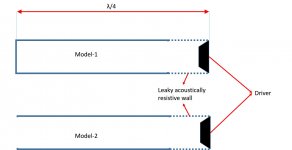The leaky part will not help establish the quarter wave resonance. It may or may not work. See if it can be simulated.
Cardioid tells something about dispersion, but does not tell you how it is obtained. A quarter wave line is an enclosure style. These are unrelated things.
Usually cardioid dispersion is obtained with two sources, separated in space, which are driven such that they cancel each other when measured (far) behind the speaker. They must cancel at all frequencies within the passband. Therefore their frequency responses must match. If one of the sources contains a resonator (like a 1/4 wave line), the other one must have one as well.
Usually cardioid dispersion is obtained with two sources, separated in space, which are driven such that they cancel each other when measured (far) behind the speaker. They must cancel at all frequencies within the passband. Therefore their frequency responses must match. If one of the sources contains a resonator (like a 1/4 wave line), the other one must have one as well.
Last edited:
TBTL,
The OP is trying to do this: operate the cardioid down till lets say ~100Hz. Then below that let it be a quarter wave resonator as if there was no leaky cardioid.
The OP is trying to do this: operate the cardioid down till lets say ~100Hz. Then below that let it be a quarter wave resonator as if there was no leaky cardioid.
